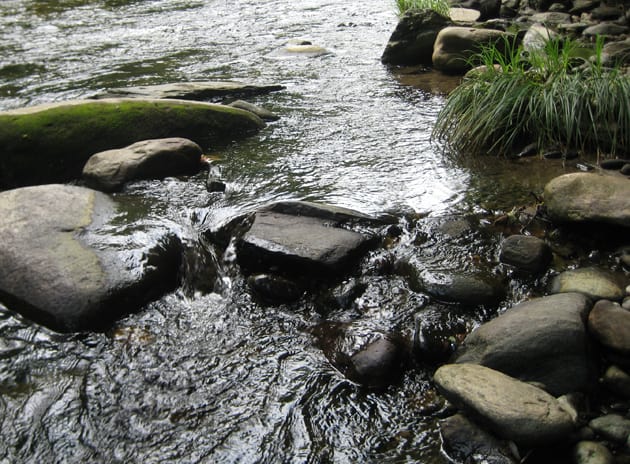Setting stones into your landscape is a great way to connect one part of a garden to another. Whether you are setting a few large rocks within a planting or arranging a backyard waterfall, keep the following principles in mind so the stones look as though they belong. As you get into the practice of setting stones in place, you may find yourself transported back to the delights of your childhood sandbox, only with large elements to capture your attention.
 photo: Val Khislavsky.
photo: Val Khislavsky.
Look to nature first before placing stones. Study landscapes and landforms such as ledge outcroppings, stream beds, waterfalls, rocky coastlines, and stony islets and use them as your guide. Note the natural patterns of your local stone as it sits in the ground. Limestone, for instance, has horizontal striations, so set it parallel to the ground rather than vertically on edge.
Make sure that your stones are set firmly into the earth. This means that you want to set them to their “knees”) about one-third of the way up from their “feet,” or bottom of the rock) or their “waist” (about halfway up from their feet). If you allow the underside of a rock to be exposed, it will look as though you simply plopped it down.
Drawing by Bethany Gracia.
Establish a relationship between or among stones. With two stones, make the larger rock the major or dominant stone, and a smaller rock the minor or subordinate stone. It helps to conjure up an image for the relationship between stones-a “mother/child” pairing, for instance, or one of leaning and supporting. When placing three or more stones, create a triangular relationship among them, such as a tall “standing” stone, a medium-size flat-topped stone, and a low “lying” stone. However many stones you set it helps immensely to have an image firmly in mind before you begin.
 photo: JMMDS.
photo: JMMDS.
When lining a stream or planting bed, use stones of different sizes. Think of how rocks look at the edge of a stream; they either pile up through deposition or are swept away through erosion. Smaller stones tumble to the side of larger rocks, varying the depth and height of the shoreline. In your landscape, as in nature, lining up stones that are all the same size looks stiff and contrived.







My partner and I stumbled over here from a different web page and thought I should check things out.
I like what I see so now i am following you.
Look forward to finding out about your web page repeatedly.